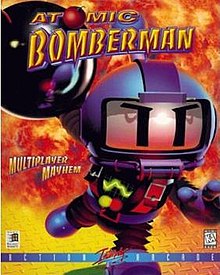Atomic Bomberman
This article needs additional citations for verification. (October 2017) |
| Atomic Bomberman | |
|---|---|
 North American cover art | |
| Developer(s) | Interplay Productions |
| Publisher(s) | Interplay Productions |
| Designer(s) | Jeremy Airey Kurt W. Dekker |
| Series | Bomberman |
| Platform(s) | Microsoft Windows |
| Release | |
| Genre(s) | Arcade, maze |
| Mode(s) | Single player, multiplayer |
Atomic Bomberman is a game by Interplay Productions for the PC that was released in 1997. It was the first original Bomberman game to be developed for Windows, and the second game of the series made for the PC, following Dynablaster.
The game is relatively unusual in the Bomberman series, as it was officially licensed from Hudson Soft and developed by an American team. Most titles in the series were developed in Japan. It has a different look and feel compared to other Bomberman titles as a result (despite basic gameplay being unchanged), using pre-rendered 3D characters and backgrounds as opposed to hand-drawn animated sprites, and extensive use of voice samples during gameplay. The voice clips are by voice actors Charlie Adler and Billy West.
Gameplay[]
Atomic Bomberman can be played in either "classic" or "enhanced" mode.[2]
Level editor[]
The game includes a hidden level editor which allows the player to edit existing maps as well as create new maps. Maps used by the game are in the form of "scheme files" (.sch filename extension). The map editor is a simple interface, showing the map, dotted with different colors (0 to 9) to represent player spawns. A function called DENSITY chooses how "dense" the collection of breakable items are. The Powerup Manager chooses the list of powerups to be included, how often, whether they can be destroyed and what happens when two conflicting powers are picked (such as Bomb Spooge vs. Power Glove). The editor also sports a basic graphic interface: the player can switch between the "Green Acres" theme and a monochrome, patterned representation.
Development[]
Atomic Bomberman was built from the code for Super Bomberman 3, which publisher/developer Interplay Productions licensed from Bomberman franchise owner Hudson Soft.[3] Project leader Jeremy Airey commented, "We're trying to make [Bomberman] a little more modern, but we don't need to change the way it plays at all."[3]
The development team had ambitions of the game supporting twice as many players as any other version of the game, until the release of Saturn Bomberman (which supports up to ten players) made this goal unrealistic.[3]
A PlayStation version was planned but never released.[4]
Reception[]
Trent Ward gave the game a 5.7 out of 10 in GameSpot. He commented while the humorous death animations and customizable characters and rules are admirable additions to the series, the online multiplayer's jerky play and odd glitches greatly compromise the most important aspect of the game.[5] GamePro said the game "really preserves the classic series' essential elements and adds only worthwhile enhancements." They particularly noted the team modes in online multiplayer, the level creator, and the well rendered characters, though they remarked that the backgrounds are sometimes overly detailed to the point of making the screen cluttered.[6]
References[]
- ^ http://www.gamefaqs.com/pc/196667-atomic-bomberman/data
- ^ "Atomic Bomberman". GamePro. No. 105. IDG. June 1997. p. 58.
- ^ a b c "NG Alphas: Bomberman". Next Generation. No. 27. Imagine Media. March 1997. pp. 48–51.
- ^ "Previews (Protos) - Bomberman". Electronic Gaming Monthly. No. 89. Ziff Davis. December 1996. p. 42.
- ^ Ward, Trent (August 15, 1997). "Atomic Bomberman Review". GameSpot. Retrieved 5 June 2019.
- ^ Dan Elektro (October 1997). "PC GamePro Review: Atomic Bomberman". GamePro. No. 109. IDG. p. 110.
External links[]
- 1997 video games
- Bomberman
- Cancelled PlayStation (console) games
- Interplay Entertainment games
- Windows games
- Windows-only games
- Multiplayer and single-player video games
- Video games developed in the United States
- Maze games